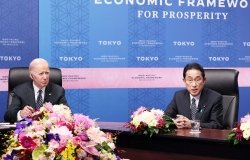Local-to-Local Energy Linkages: California and Alberta in China
In light of the minimal cooperation between the U.S. and Canadian governments with China’s central government on energy, some U.S. states and Canadian provinces have begun to pursue effective forms of engagement with local-level Chinese counterparts on energy.
Overview
Both the Canadian and U.S. governments have numerous bilateral agreements and memorandums of understanding with China's central government on energy, but overall the actual cooperation has been much less than what might be promised on paper. To fill this void, some U.S. states and Canadian provinces, as well as nongovernmental organizations (NGOs) and research centers in both countries, are pursuing very effective forms of engagement with local-level Chinese counterparts on energy. However, such local-to-local partnerships are still in their infancy. While many local governments in Canada and the United States have sister or twining relationships with China, the vast majority are based on economic and cultural ties. This is primarily due to lack of financial capacity and mandate to dedicate work overseas at the local-level. But with central governments in the hemisphere lagging in economically and environmentally profitable cooperation, many local governments are seeking ways to work with their Chinese counterparts, who are increasingly responsive on energy particularly as they struggle to meet stringent environmental goals set by the central government. In fact, with new laws now threatening local government leaders' jobs based on their energy performance, these relationships may become even more mutually beneficial and immediately necessary.
The California-Jiangsu Energy Partnership
The Partnership
Ten years ago the Natural Resources Defense Council (NRDC) discovered that it met most resistance at the local level in its extensive work with the central government on energy efficiency and demand side management (DSM), or actions that targeting end users to influence the quantity or pattern of energy use, as at the local level where there were strong incentives to prioritize GDP growth at the expense of the environment. Due to its level of growth, NRDC decided to target Jiangsu for energy work, but their projects met with little enthusiasm as energy at that time was plentiful and cheap. However, in 2003, energy shortages began and have since continued to intensify across the country making DSM a successful option for load management, says NRDC's Bo Shen. The high average load factors suggests that there is little to be gained by load management underscoring how energy efficiency may be the best way to decrease peak and long-term energy demand. Jiangsu was very interested in working with California as it was able to increase GDP by 40 percent over the last 30 years while keeping energy demand flat.
In 2005, California utilities regulators visited Jiangsu and signed cooperation agreements to help the province reduce its dependence on coal-fired power plants through training, study tours, technology seminars, and technical support for energy efficiency projects. The MOU they signed with Jiangsu was the first to commit a provincial government to promoting energy efficiency. The implementation agencies for the MOU are California Public Utilities Commission (CPUC) and Jiangsu Demand Side Management Center.
California and Jiangsu are natural partners for energy efficiency. The southern province of Jiangsu is China's fastest growing province, with its GDP rising at double digits for 16 years and per capita GDP at $4,300. It has a population of 76 million, compared with California's 36 million. This rapid economic growth is accompanied by growing energy demand, which rose 18 percent annually in the past five years: 95 percent of which comes from coal.
California has a great deal of technical and policy expertise with regards to energy efficiency to share with China, says California Public Utilities Commissioner Dian M. Grueneich. In 2006, California passed the Global Warming Solutions Act (AB32) as a framework to reduce the state's CO2 emissions to 1990 levels by 2020, taking into account the volume of imported energy. California saves 2 dollars for every dollar it puts into energy efficiency. Lacking a mandate for international relations, it is California's current leaders who have pushed international energy projects not only in China, but in other countries as well.
The Problem
In Jiangsu, as well as the rest of China, energy efficiency is perceived as a tool or short-term solution as opposed to a resource. As a consequence, there is a lack of an institutional structure that supports energy efficiency. The local and central governments are currently devising a way to institutionalize energy efficiency, either through government utilities or NGOs. However, they are reticent to invest in energy efficiency because managers and other local officials have a term limit of 3-5 years so the benefits will not be realized within their terms. Moreover, there is limited information on the cost of energy consumption and solutions. If there is a high opportunity cost, a facility manager may want to invest elsewhere, which is a particularly salient problem due to limited access to capital, loans and financing. There is also a lack of access to technology because facilities managers are not able to buy in bulk. They are also wont to distrust smaller service providers, despite the fact that there are very few large providers.
Partnership-Based Solutions
With the support of NRDC and CPUC staff, Jiangsu Province has secured strong support from California. Jiangsu province and California have cooperated to develop a strategic energy blueprint projected to last until 2015. Operating under this blueprint, energy savings could equal the output of 26 coal-fired power plants. The resources gained from energy efficiency under this program would meet 10 percent of Jiangsu's projected electricity growth and 15 percent of peak demand growth.
Other major initiatives by NRDC and CPUC include: (1) organizing the first national DSM forum to promote energy as a cost-effective resource; (2) publishing a national DSM implementation manual to ensure the standardization of procedures; (3) developing an incentive program in which 100 million Yuan are earmarked annually for energy efficiency; (4) establishing the non-profit China-U.S. Energy Efficiency Alliance in California to promote technology sharing; and (5) offering a financing option that maximizes potential in addition to giving direct cash, thus helping to attract more money from other organizations. Jiangsu is currently working with California to explore other options, such as developing an energy service company (ESCO) that may be available to them in this very promising relationship.
In the last four years, Jiangsu has saved about 2 billion kilowatts of electricity annually. It has also reduced CO2 emission by 92 million tons and SO2 emission by 1.84 million tons. In 2007, it reduced its energy intensity (energy consumption per 10,000 GDP) by 4.3%.
Alberta-China Local Initiatives
Alberta has yet to institutionalize local-to-local cooperation, though it has introduced many promising initiatives. Like California, Alberta has extensive energy policy and technical expertise derived from mitigating its own energy challenges. Alberta has an impressive environmental record despite its possession of extensive oil reserves. In 2007, it became the first province in Canada to make green house gas emissions reductions, an achievement that included the more efficient use and reuse of energy. According to Canadian Embassy representative Gary Mar, this accomplishment is the equivalent of taking 550 vehicles off the road every year, and Alberta plans to take the equivalent of 42 million cars off the road by 2050, as it implements a carbon capture program. Also like California, Alberta has enterprising leaders that have worked to encourage international interactions. Relationships with China naturally extended from economic and cultural sister relationships, such as that between Edmonton and Harbin. Under the auspices of this relationship the two cities recently completed a CO2 sequestration project. Moreover, Edmonton has recently extended beyond its sister relationship to begin a waste management project with Chengdu.
Another important cooperation between Alberta and China is the University of Alberta's China Institute, which is the only university outside of China to have access to China's state laboratories through the Ministry of Science and Technology. The institute runs on 7 million dollars from China and a matched contribution from Alberta. The purpose of the institute is manifold and includes increasing the general study of China, conducting student exchanges, and expanding research and business opportunities between Canada and China.
Further Potential of Local-to-Local
Reflecting on a recent trip to China, Dr. Wenran Jiang suggested that in the wake of the recent earthquake China is experiencing a "shock of consciousness awakening" as people realize that the current pace of development produces byproducts like the weak "tofu structures" that toppled this month. He believes this awakening will lead to greater attention to sustainable development models, which result in a larger bilateral energy efficiency efforts.
Local level—state-to-province, province-to-province, or city-to-city—partnerships are still a new phenomenon. There have been many twinning s and sister cities, but the extent to which they can evolve into environmental cooperation has yet to be determined. Moreover, these sister cities are not representative of the larger picture. They do, however, present a huge opportunity to turn superficial relationships into genuine cooperation.
In addition to the models of California and Alberta, Jiang pointed to two other models for local cooperation. The first is the U.S. and Canada-based Energy Council, which represents eleven U.S. oil producing states, five Canadian oil producing provinces, and Venezuela. This state-level energy council wanted to adopt a similar model—based on mutual inclusion at the state level—to work with China on energy. Notably, Alberta was the first Canadian province to join the council. In the past few years, the council has seen interesting new developments: it has gone to the NRDC in China to talk to oil and energy companies about a range of issues. During the investigations they discovered that U.S. representation in China is primarily connected to selling and promoting nuclear energy in China, thus leaving many opportunities for state-level cooperation. The second model of cooperation is regional, such as the Pacific Northwest Economic Region (PNWER), which has been actively engaging China on the environmental front, though they have not yet seen success in institutional engagement.
Challenges to local level cooperation are considerable, although arguably necessary given Canada and the U.S.'s environmental stagnation at the central level. The first major challenge to local-to-local initiatives is the Chinese reluctance to respond to North American demands to lead a more efficient life. The issue is not that they are unwilling to engage with North America; they simply prefer to work with Japan and the EU on energy efficiency and the environment because they perceive Japan and the EU as more successful on those fronts. Thus, it is imperative that the United States and Canada do much more to reduce their own carbon footprints and address the lifestyles their citizens lead as they engage China. Another challenge is finding a way to convince central governments that local governments and NGOs matter. At annual energy meetings in China, representatives are not states and provinces but central officials. Private companies want to invest in and commit to energy efficiency, but without support from the federal government, they do not seem willing to invest in the private sector let alone local governments. The third challenge is determining the forms in which states and provinces can actually cooperate concretely. Jiangsu's relationship with California is very concrete, while Alberta has established a more ad hoc technology transfer but with few concrete successes regarding the environment. To a great extent, the success stories have been due to favorable conditions such as the presence of a devoted civil society, local political enthusiasm, large Chinese-national populations, and perhaps, direct pollution impacts from China.
Other upcoming plans to cooperate local-to-local include British Columbia signing an energy cooperation agreement with China and Japan's many city-to-city initiatives, but few models exist to design new projects around. Lacking real mandate and funding for international projects, California is turning to sharing information, in which new media will play a significant role. For example, the state is in the process of setting up a major webportal on energy efficiency that will make California's tremendous amount of technical knowledge available to China. The webportal will not only share information with the international community, but provide a forum where energy policies can be subject to interactive discussions. In addition, some of these policies will be translated into Chinese.
Documents & Downloads
Speakers
Bo Shen
Dian M. Grueneich
Gary Mar

Wenran Jiang
Project Director, Canada-China Energy and Environment Forum, Special Advisor to Alberta Minister of Energy, and Senior Fellow of Asia Pacific Foundation of Canada, Canada
Hosted By

China Environment Forum
Since 1997, the China Environment Forum's mission has been to forge US-China cooperation on energy, environment, and sustainable development challenges. We play a unique nonpartisan role in creating multi-stakeholder dialogues around these issues. Read more

Environmental Change and Security Program
The Environmental Change and Security Program (ECSP) explores the connections between environmental change, health, and population dynamics and their links to conflict, human insecurity, and foreign policy. Read more

Canada Institute
The mission of the Wilson Center's Canada Institute is to raise the level of knowledge of Canada in the United States, particularly within the Washington, DC policy community. Research projects, initiatives, podcasts, and publications cover contemporary Canada, US-Canadian relations, North American political economy, and Canada's global role as it intersects with US national interests. Read more
Thank you for your interest in this event. Please send any feedback or questions to our Events staff.










